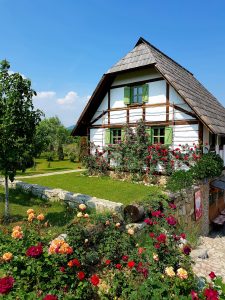Introduction: biophilic design
Biophilic design represents a belief that recognizes our innate connection with nature. It also acknowledges the positive impact it has towards our general welfare. By incorporating biophilic design principles into your garden, you can create an area outdoors that nurtures your senses, promotes well-being, and restores a sense of harmony. This guide explores the principles of biophilic design. It provides insights on methods for integrating nature’s healing power into your garden. From sensory experiences and natural materials to greenery and biodiversity, discover the transformative potential of nature-inspired architecture in your outdoor oasis.
Comprehending the Principles of Biophilic Design
Biophilic design aims to create environments that connect us with nature and uplift our overall wellness. It recognizes the importance of our innate relationship with the outdoors. They desire to incorporate natural elements into our built environments. Biophilic design principles include providing sensory experiences, integrating natural materials, incorporating greenery and biodiversity, and encouraging a feeling of happiness. By understanding these principles, we can create gardens that evoke with our deep connection to nature.
Sensory Interactions: Engaging with Nature’s Elements: biophilic design
Sensory experiences are crucial in biophilic design. Design your yard to engage all of your senses. Incorporate elements like water features, chimes that jingle, or bird feeders to create soothing sounds. Utilize fragrant plants and flowers to stimulate your nose’s perception. Design pathways or zones for resting that invite touch and interaction with different textures. Embrace lighting techniques that mimic the patterns of natural light. By engaging your senses, your garden transforms into a spot of sensory delight and connection to nature.

Natural Materials: Incorporating Natural Elements in Your Garden
Sustainable materials play a significant role in biophilic design. Incorporate organic components such as wood, stone, or bamboo in your garden design. Use natural materials for pathways, seating areas, or outdoor constructions. Embrace the imperfections and textures found in natural materials to form a perception of authenticity. This will help to attain unity in your design. Natural materials not only add visual appeal but also generate a grounded sensation and connected to the earth.
Greenery and Biodiversity: Building a Home for Living Things
Flora and fauna are fundamental aspects of biophilic design. Incorporate a diverse plant species, trees, and shrubs to create a lush and vibrant garden. Aim for many different of species to support local ecosystems and promote biodiversity. Consider creating habitats for wildlife, like bird shelters or pollinator-friendly plants. This will bring in wild visitors to your garden. By embracing greenery and biodiversity, your backyard turns into a living ecosystem. It fosters a stronger bond to nature.
Enhancing Well-being: The Curative Abilities of the Outdoors in Your Garden
The healing power of nature is at the core in biophilic architecture. Design your garden as a space for calm, thought, and refreshment. Construct sitting areas that invite peaceful reflection or meditation. Incorporate elements like water features or wind movements to create a tranquil and serene environment. Provide shaded areas for break from the sun. By enhancing well-being through your garden design, you make an area that promotes mental and physical health. This brings the healing ability of nature into your daily life.
Conclusion:
Incorporating biophilic design guidelines in your garden allows you to harness nature’s healing power. It also helps create a harmonious outdoor space. By actively involving senses, utilizing natural materials, embracing greenery and biodiversity, and enhancing well-being, you can transform your garden into a sanctuary that nourishes your soul. It also promotes a sense of bond to the natural world. Embrace the principles involving natural elements and let your garden become a space of tranquility, inspiration, and healing. Here, you can find solace, rejuvenation, and a sincere recognition for the beauty and wonder of nature.




